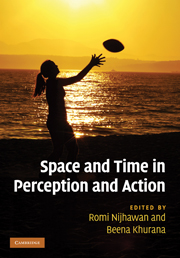Book contents
- Frontmatter
- Contents
- List of contributors
- Acknowledgments
- 1 Space and time: the fabric of thought and reality
- Part I Time–space during action: perisaccadic mislocalization and reaching
- Part II Temporal phenomena: perception
- Part III Temporal phenomena: binding and asynchrony
- Part IV Spatial phenomena: forward shift effects
- 19 The Fröhlich effect: past and present
- 20 Approaches to representational momentum: theories and models
- 21 Conceptual influence on the flash-lag effect and representational momentum
- 22 Perceptual asynchronies and the dual-channel differential latency hypothesis
- 23 Paying attention to the flash-lag effect
- 24 Illusions of time, space, and motion: flash-lag meets chopsticks and reversed phi
- 25 Bridging the gap: a model of common neural mechanisms underlying the Fröhlich effect, the flash-lag effect, and the representational momentum effect
- 26 Perceiving-the-present and a unifying theory of illusions
- 27 History and theory of flash-lag: past, present, and future
- Part V Space–time and awareness
- Index
- References
19 - The Fröhlich effect: past and present
from Part IV - Spatial phenomena: forward shift effects
Published online by Cambridge University Press: 05 October 2010
- Frontmatter
- Contents
- List of contributors
- Acknowledgments
- 1 Space and time: the fabric of thought and reality
- Part I Time–space during action: perisaccadic mislocalization and reaching
- Part II Temporal phenomena: perception
- Part III Temporal phenomena: binding and asynchrony
- Part IV Spatial phenomena: forward shift effects
- 19 The Fröhlich effect: past and present
- 20 Approaches to representational momentum: theories and models
- 21 Conceptual influence on the flash-lag effect and representational momentum
- 22 Perceptual asynchronies and the dual-channel differential latency hypothesis
- 23 Paying attention to the flash-lag effect
- 24 Illusions of time, space, and motion: flash-lag meets chopsticks and reversed phi
- 25 Bridging the gap: a model of common neural mechanisms underlying the Fröhlich effect, the flash-lag effect, and the representational momentum effect
- 26 Perceiving-the-present and a unifying theory of illusions
- 27 History and theory of flash-lag: past, present, and future
- Part V Space–time and awareness
- Index
- References
Summary
Summary
When observers are asked to localize the initial position of a moving target, they often indicate a position displaced in the direction of motion relative to the true onset position. In this review, the debate between Fröhlich, who discovered this phenomenon, and his contemporaries in the 1920s and 1930s is summarized. Striking misinterpretations of Fröhlich's findings and the anticipation of recent research on the flash-lag effect will be presented. In the second part, current accounts of the Fröhlich effect in terms of attention and metacontrast are evaluated. In the final section, reconciliation between research on the Fröhlich effect and recent reports of an error opposite the direction of motion (the onset repulsion effect) is offered.
Introduction
When asked to localize a moving target entering a window, observers often indicate a position not adjacent to the edge of the window but a position displaced in the direction of motion (see Fig. 19.1(a)). The gap between the edge of a window and the initial perception of the moving target was first discovered by the Norwegian astronomer O. Pihl in 1894, but Fröhlich (1923) was the first to study the effect systematically. Therefore, the illusion has been named the “Fröhlich effect.” Fröhlich's explanation of the illusion in terms of “sensation time” was amply discussed in the 1930s (Fröhlich 1930, 1932; Rubin 1930; G. E. Müller 1931; Metzger 1932; Piéron 1935) but forgotten for the 60 years that followed.
- Type
- Chapter
- Information
- Space and Time in Perception and Action , pp. 321 - 337Publisher: Cambridge University PressPrint publication year: 2010
References
- 12
- Cited by



